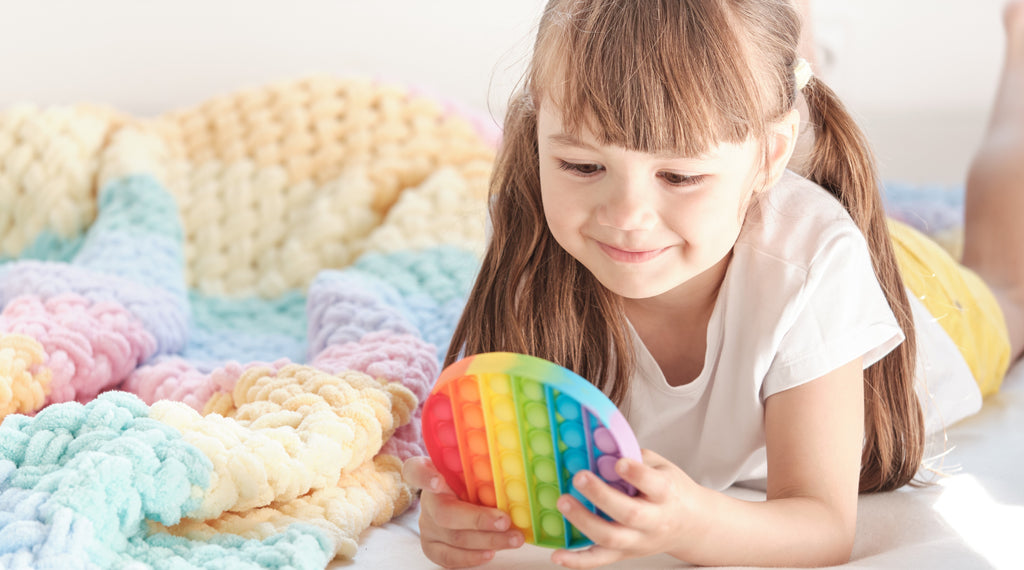
Does your child repeat the same action, movement, or speech over and over again? Perhaps you’ve noticed that your child talks about one topic for a really long time - almost to the point of obsession. Or maybe you’ve seen that your child is constantly doing the same movement or action, such as fidgeting or flapping their hands.
If you have a child with Autism Spectrum Disorder, then you probably already know that restrictive and repetitive behaviors are two significant components of the diagnosis. However, there is an actual term to describe these behaviors; it is called perseveration. Although anyone can exhibit it at any given moment, it is most common to witness perseveration in Autism.
You already know that at Simple Spectrum, we want to provide you with information and resources that will help you and your family navigate the challenges that come along with Autism. So without further ado, let’s talk about perseverative behaviors in children.
Perseveration
Do not be intimidated by the term because perseverative behavior is simply a repetitive behavior that causes a person to “get stuck” on a topic, action, or idea. Without further explanation, you might think that this seems like a fairly common thing that happens to everyone when they fixate on something. And yes, fixating on something is definitely something that everybody does, but there is a lot more to unpack and understand when discussing perseveration in individuals, specifically children with ASD.
One of the most important things to understand about individuals who perseverate is that it is an involuntary fixation that causes the individual to feel “stuck” unintentionally. So why does perseveration happen and why is it associated with children who have Autism? Well, suppose a child is exhibiting signs of perseveration. In that case, it can usually be considered an involuntary coping mechanism for a child experiencing a sensory overload or feeling overwhelmed.
Signs of Perseveration
Perseverative behaviors can manifest in several ways and each might look different for every child. The three most common signs of perseveration fall into one of the following categories:
- Verbal Perseveration- Repetitive speech, sounds, or combination of the two. The child might talk about the same thing or ask the same questions even if they just heard the answer. They may hyperfocus on one topic and learn everything they can about it before talking about it for hours on end. Verbal perseveration usually does not serve a social purpose; it is simply a form of repetitive behavior.
- Motor Perseveration- Repetitive movement of the body that is unintentional. In children, motor perseveration might look like fidgeting, spinning, flinging, or toys back and forth. They might also hold on to something longer than expected or even line up all of their toys over and over again.
- Cognitive Perseveration- Repetitive and involuntary thoughts. Cognitive perseveration can mean that the individual is struggling to get past certain emotions like anger or fear. But according to one study, Repetitive cognition is a tendency to perseverate on particular thoughts, often accompanied by difficulty disengaging with these thoughts; repetitive cognition ranges from the fixation on favorite topics or activities (whether actually doing these activities or merely thinking about them) to rumination, which is a perseveration on negative thoughts noted in typically-developing individuals with depression.”
What To Do When Your Child Is Exhibiting Perseverative Behavior
Parenting is one of the most rewarding experiences but if you are reading this, you also know how challenging it can be. Healthy parenting comes down to finding a good balance, and if you are raising a child with ASD, it may be slightly more challenging to find a balance that works for you and your child. We recently discussed Autistic meltdowns in children and how parents can effectively deescalate them safely and healthily; a lot of what we discussed carries over when dealing with perseveration in Autism.
Having conversations with your child about what perseveration is can be an extremely helpful tool for parents. The key to these conversations is to have them when the child is not exhibiting perseverative behavior. This might help a child to identify when signs of repetitive behavior are showing. On the other hand, having this conversation with a child who is already perseverating may not be effective at all because they may not be able to “hear” or listen to what you are saying.
The most critical thing you can do for your child when they are displaying signs of perseveration is to respond with empathy. Always practice empathy with your child in these difficult situations. Remember that getting “stuck” or showing signs of perseverative behavior is not a choice and is usually a response to overstimulation.
At Simple Spectrum, we know that dealing with perseveration in children can be tricky, and as a parent, you will always wonder if you are doing enough. Every day might present a new set of challenges for you and your family, but remember that knowledge is power. The more you educate yourself on Autism Spectrum Disorder, the more prepared you might be for tomorrow’s challenges!
